Original title: Sugar High
Author: Arthur Hayes, founder of BitMEX; Translator: Deng Tong, Golden Finance
I ended my summer vacation in the northern hemisphere in a script-changing way, heading to the southern hemisphere for two weeks of skiing. I spent most of my time on backcountry skiing trips. For those who haven't yet enjoyed the joy of this activity, the activity involves attaching skins to the bottom of the skis so that you can slide up the mountain. Once you arrive at your destination, remove the skins, set the boots/skis to downhill mode, and then tear up the juicy powder snow. Most of the mountains I visited are only accessible this way.
A typical four to five hour day consists of 80% uphill skiing and 20% downhill skiing. Therefore, this activity is very energy-intensive. Your body burns calories and heats itself to maintain homeostasis. Your legs are the largest muscle group in the body, and they are constantly working whether you are climbing a mountain or skiing downhill. My basal metabolic rate is close to 3,000 kcal; combined with the energy required for my legs, my total daily energy intake is over 4,000 kcal.
Because of the high amount of energy required to complete this activity, the combination of foods I consume throughout the day is critical. I eat a large breakfast in the morning, including carbohydrates, meat, and vegetables; what I call "real food." Breakfast fills me up, but this initial energy reserve is quickly depleted as I enter the cold forest and begin the initial climb. To control my blood sugar levels, I bring snacks that I would normally avoid, just like Su Zhu and Kylie Davies avoid liquidators appointed by the British Virgin Islands bankruptcy court. Even if I'm not hungry, I eat a Snickers bar and a candy bar every 30 minutes on average. I don't want my blood sugar level to drop too low and disrupt my blood flow.
Eating sugary processed foods is not a long-term solution to my energy needs. I also need to eat "real food." After each lap I usually stop for a few minutes, open my backpack, and eat part of the "meal" I prepared. I prefer a Tupperware box filled with chicken or beef, sautéed leafy greens, and plenty of white rice.
To keep performing throughout the day, I combine periodic sugar highs with longer-burning, cleaner fuel from "real food."
The purpose of describing my ski trip meal prep is to elicit a discussion about the relative importance of price versus quantity of money. To me, the price of money is like the Snickers and candy bars I eat for a quick glucose boost. Quantity of money is like the slow, long, burn of "real food." The Federal Reserve (Fed) has finally committed to lowering its policy rate after Powell announced a salary adjustment at Jackson Hole's Central Jerk Circle last Friday. In addition, officials from the Bank of England (BOE) and the European Central Bank (ECB) have also indicated that they will continue to lower their policy rates.
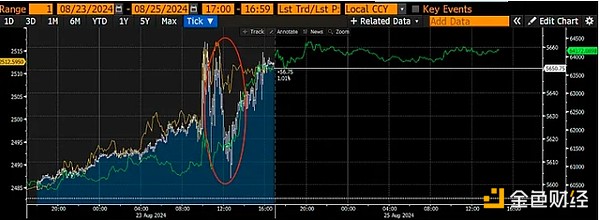
Powell announced the shift around 0600 GMT, corresponding to the red oval. Risk assets such as the S&P 500 (white), gold (gold), and Bitcoin (green) all rose as currency prices fell. The US dollar (not shown in the chart) also closed weaker for the week.
The initial positive market reaction was justified as investors believed that assets denominated in fixed-supply fiat dollars should rise if currencies are cheaper. I agree; however… we forget that future expected rate cuts from the Fed, BoE, and ECB will reduce the interest rate differentials between these currencies and the yen. The danger of the yen carry trade unwinding will reappear and could spoil the event unless the "real money" of the central bank's balance sheet expansion (i.e. printing money) increases the amount of money. (For details, see "Arthur Hayes on the 805 crash: How will the United States and Japan respond? How to trade in the future? ")
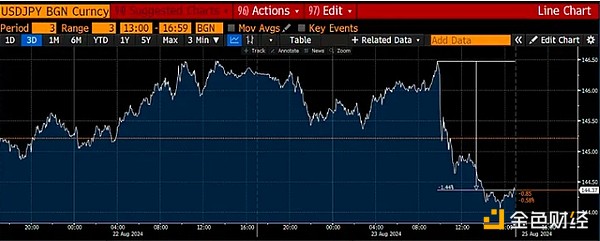
The dollar rose 1.44% against the yen, while the dollar fell immediately after Powell's change of position. This is to be expected, as falling USD rates lead to narrowing USD/JPY differentials going forward, while rising JPY rates lead to flat USD/JPY rates.
The remainder of this article is intended to reinforce this point and present my outlook for the critical months ahead, before an apathetic US electorate elects an “Orange Man” or a “Chameleon.”
Bull Thesis Assumptions
As we saw in August this year, a rapidly strengthening JPY implies a recession in global financial markets. If rate cuts in the world’s three largest economies lead to a stronger JPY against their currencies, then we should expect a negative market reaction. We will be faced with a battle between positive forces (rate cuts) and negative forces (a stronger JPY). Given the tens of trillions of dollars of global financial assets financed in yen, I believe that there will be a negative market reaction due to the rapid unwinding of yen carry trades as the yen strengthens rapidly, which will offset any benefit from a small rate cut in the dollar, pound, or euro. Furthermore, I believe that the wizards and sorcerers at the Fed, the Bank of England, and the ECB recognize that they must be willing to unwind and expand their balance sheets to offset the adverse effects of a stronger yen.
In line with my skiing analogy, the Fed is already seeking the sugar of rate cuts before hunger sets in. From a purely economic perspective, the Fed should be raising rates, not cutting them.
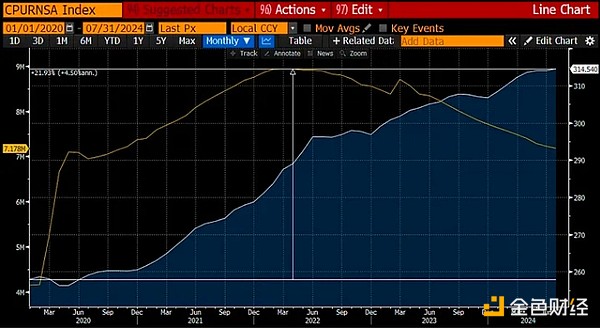
The manipulated US Consumer Price Index (white) has risen 22% since 2020. The Fed's balance sheet (gold) has increased by more than $3 trillion.
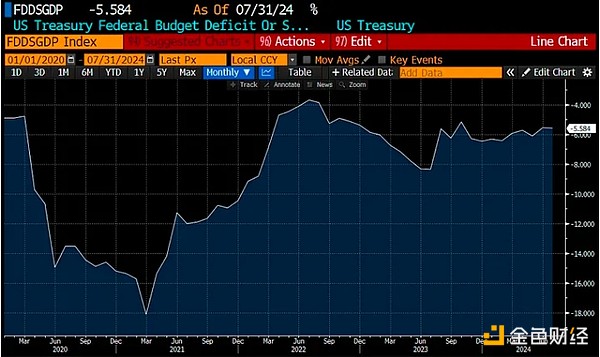
The U.S. government deficit is at a record high, in part because the cost of issuing debt is not high enough to force politicians to raise taxes or reduce subsidies to balance the budget.
If the Fed really wanted to maintain confidence in the dollar, it would raise interest rates to dampen economic activity. That would make prices lower for everyone, but some people would lose their jobs. It would also discourage government borrowing because the cost of issuing debt would go up.
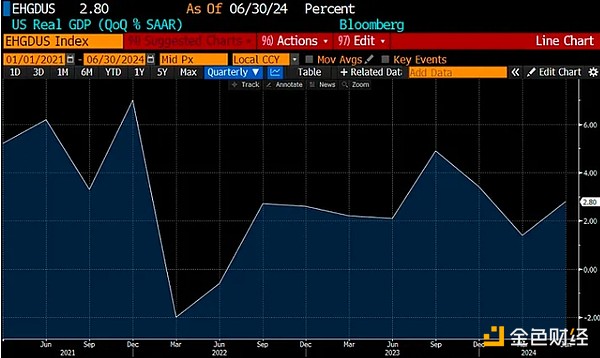
After the epidemic, the US economy has only experienced two quarters of negative growth in real GDP. This is not a weak economy that needs to cut interest rates.
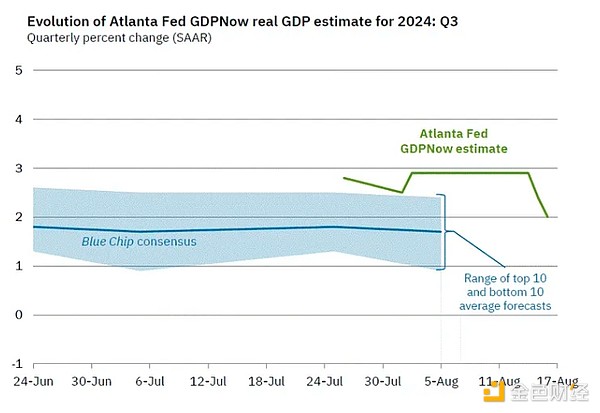
Even the most recent estimate of real GDP in the third quarter of 2024 has stabilized at +2.0%. Likewise, this is not an economy that is subject to overly restrictive interest rates.
Just like I eat candy and gummy bears when I am not hungry to avoid a drop in my blood sugar levels, the Fed is committed to never letting financial markets stop rising. The United States is a highly financialized economy that needs fiat asset prices that only go up so that people feel rich. Stocks are flat or even down in real terms, but most people don't look at their real returns. Stocks that are rising nominally also drive capital gains tax revenue in a fiat sense. In short, market declines are not good for the financial health of the United States. So bad girl Yellen started to subvert the Fed's rate hike cycle in September 2022. I believe that Powell, under the instructions of Yellen and Democratic leaders, is eating his own sows by cutting rates when he knows he shouldn't.
I give the chart below to illustrate what happens when the US Treasury, under Yellen's control, starts issuing large amounts of T-bills, which suck the sterilized funds from the Fed's reverse repurchase program (RRP) into the broader financial markets.
To understand what I said in the previous paragraph, please read my article 《Arthur Hayes: How much is the next stop for BTC? When will the altcoin season come》.
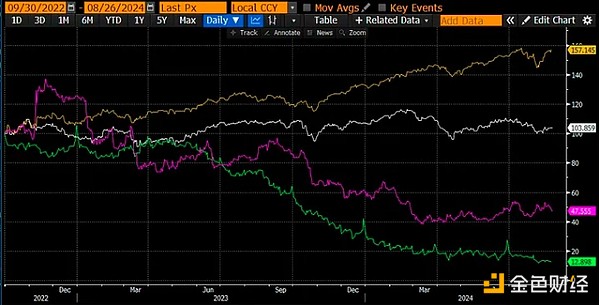
All prices are indexed to 100 on September 30, 2022; this was the peak of RRP, which was about $2.5 trillion. RRP (green) fell 87%. The nominal fiat dollar return on the S&P 500 (gold) rose 57%. I continue to say that the US Treasury is more powerful than the Fed. The Fed has been raising the price of money until March 2023, but the Treasury has designed a way to increase the quantity of money at the same time. The result is a booming stock market in nominal terms. In real terms of gold, the oldest form of real money (everything else is credit), the S&P 500 (white) is up just 4%. In real terms of Bitcoin (the new hardest real money), the S&P 500 (magenta) is down 52%.
The US economy is not hungry for rate cuts, but Powell will provide sugar anyway. Since monetary authorities are extremely sensitive to any disturbance of nominal fiat stock price increases, Powell and Yellen will soon provide "real food" in the form of some form of Fed balance sheet expansion to offset the impact of yen strength.
Before I discuss yen strength, I want to quickly touch on Powell's ridiculous rationale for rate cuts and how it further reinforces my belief in higher risk asset prices.
Powell changed his stance based on a terrible jobs report. Just days before Powell spoke at Jackson Hole, President Biden’s Bureau of Labor Statistics (BLS) released a stunning negative revision to employment data. They noted that the job estimate was about 800,000 too high.
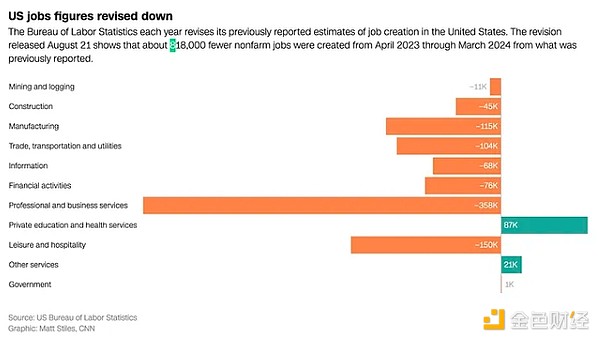
Biden and his crooked economist backers have been touting the strength of the labor market during his administration. This strength puts Powell in the awkward position of senior Democratic senators like Elizabeth “Pocahontas” Warren calling on him to cut rates and stimulate the economy before the big bad Orangeman wins the election. Powell is in a bind. Powell can’t cut rates based on falling inflation because inflation is above the Fed’s 2% target. Powell also can’t cut rates citing a weak labor market.
Biden got kicked off the Obamas’ books after he acted like an incoherent catatonic schizophrenic on prescription meds during his debate with Trump. Cameleon Harris is in office, and if you believe the mainstream media propaganda, he had nothing to do with any of the policies enacted by the Biden/Harris administration over the past four years. So the BLS can admit to its missteps without it affecting Harris, who was never really involved in the administration she was Vice President for. Wow – political Jedi magic.
Powell was allowed to blame the rate cuts on the bad labor market, but he didn’t take advantage of it. Now that he has announced the Fed will start cutting rates in September, the only question is how big the first cut will be.
I feel more confident in my predictions when politics precedes economics. This is because of Newtonian political physics - politicians in power want to stay in power. They will do whatever it takes to get re-elected, regardless of the state of the economy. This means that no matter what happens, the incumbent Democrats will use all monetary levers to ensure that the stock market rises before the November election. The economy should not be short of cheap and abundant dirty fiat money.
Yen Collapse
One big factor that affects currency exchange rates is interest rate differentials and expectations of how interest rates will change in the near future.
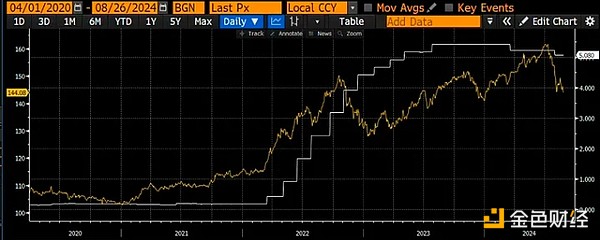
The above chart shows the USD/JPY exchange rate (yellow) and the USD/JPY interest rate differential (white). The interest rate differential is the effective federal funds rate minus the Bank of Japan overnight deposit rate. When USD/JPY rises, the yen weakens and the dollar strengthens; when USD/JPY falls, the opposite is true. When the Fed began its tightening cycle in March 2022, the yen weakened significantly. In July of this year, the yen weakening peaked and the interest rate differential was close to the maximum.
The yen strengthened significantly after the Bank of Japan raised its policy rate by 0.15% to 0.25% in late July. The Bank of Japan made it clear that it would start raising interest rates at some point in the future. The market just doesn't know when they will start raising interest rates in earnest. Like unstable snow, you never know which snowflake or which turn on the skis will trigger an avalanche. A 0.15% reduction in the big spread should be insignificant, but it is not. The yen appreciation momentum has begun, and now the market is highly focused on the future direction of the USD-JPY interest rate differential. As expected, the yen strengthened after Powell's shift in stance, and the rate differential is expected to narrow further.
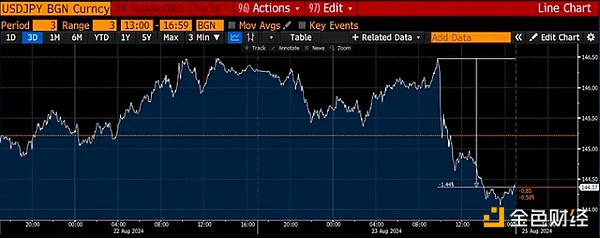
This is the same USDJPY chart from before. I would like to highlight again that the yen strengthened after Powell confirmed that the September rate cut is a done deal.
The sugar highs from the Fed rate cut could be short-lived if traders resume unwinding USDJPY carry trade positions amid yen appreciation. Further rate cuts to stem the decline in various financial markets will only accelerate the pace of the narrowing of the USD/JPY differential, which in turn will push the yen higher and cause more positions to be unwound. The market needs "real money" in the form of money printing provided by the growing Fed balance sheet to stop the bleeding.
If the yen strengthens at an accelerated pace, the first step will not be to resume QE money printing. The first step will be for the Fed to reinvest cash from maturing bonds in its portfolio into Treasuries and mortgage-backed securities. This will announce the end of its quantitative tightening (QT) program.
If the pain train continues to whine, the Fed will resort to using central bank liquidity swaps or resume QE money printing. Behind the scenes, bad girl Yellen will increase dollar liquidity by selling more Treasuries and reducing the total Treasury account. Neither of these market manipulators will use the destabilizing effects of the unwinding of the yen carry trade as a reason to resume aggressive money printing. It is not in the American nature to acknowledge any other country’s influence on the Glorious Empire of Liberal Democracy!
If the USDJPY exchange rate falls below 140 for any short period of time, I am sure they will not hesitate to provide the “real food” that the filthy fiat financial markets need to survive.
Favorable Factors for Crypto Trading
Fiat liquidity conditions could not be better as we enter the final stages of Q3. As crypto holders, we have the following favorable factors:
1 - Central banks around the world, currently led by the Federal Reserve, are lowering the price of their currencies.The Fed is cutting rates while inflation is above its target and the US economy continues to grow. The Bank of England and the European Central Bank are likely to continue cutting rates at their upcoming meetings.

2 - Bad Girl Yellen promises to issue $271 billion in Treasury bills and conduct $30 billion in repurchases between now and the end of the year. This will add $301 billion in dollar liquidity to financial markets.
3 - The U.S. Treasury has about $740 billion left in the TGA, which can and will be used to stimulate the markets and help Harris win.
4 - The Bank of Japan raised rates by 0.15% at its July 31, 2024 meeting, and then became so frightened by the pace of the yen's appreciation that it publicly stated that future rate hikes would take market conditions into account. This is a euphemism for "if we think the market will fall, we won't raise rates."
I'm a crypto enthusiast, and I don't do stupid things. Therefore, I don't know if stocks will rise. Some people point to historical instances when the Fed cuts rates and stocks fall. Some worry that Fed rate cuts are a leading indicator of recessions in the U.S. and even in developed markets. This may be true, but if the Fed cuts rates when inflation is above target and growth is strong, imagine what they would do if the U.S. actually had a recession. They would increase the printing presses and significantly increase the money supply. This would cause inflation, which could be bad for certain types of businesses. But for an asset like Bitcoin, which has a limited supply, it would provide a trip to the moon at the speed of light!
 Xu Lin
Xu Lin
















